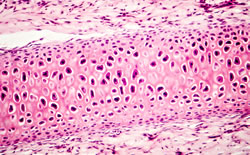Recent News & Events
Synthetic Bone Implant Produces Blood Cells and Improves Blood and Immune Disorder Research and Treatment
30
 Patients with bone marrow diseases can get bone marrow transplants. However, this treatment method usually causes uncomfortable and damaging side effects such as fatigue, nausea and fertility loss. To improve the treatment of blood and immune disorders, researchers at the University of California, San Diego have engineered a synthetic bone implant that resembles real bone and produces healthy, functional blood.
Patients with bone marrow diseases can get bone marrow transplants. However, this treatment method usually causes uncomfortable and damaging side effects such as fatigue, nausea and fertility loss. To improve the treatment of blood and immune disorders, researchers at the University of California, San Diego have engineered a synthetic bone implant that resembles real bone and produces healthy, functional blood.
Current Bone Marrow Disease Treatment
At the center of bones is a spongy tissue called bone marrow. One of its functions is to use stem cells to produce red blood cells. Transplants are treatments that replace the bone marrow when immune and blood disorders attack the stem cells.
However, bone marrow disease patients have to undergo radiation and sometimes take drugs before the transplant to kill any of their remaining stem cells. The purpose of this step is to improve the chances for successful transplants. Essentially, it cleans up the host bone marrow so that donor cells can survive and grow without having to fight the host cells. The entire treatment process is very hard on patients.
The Engineered Bone Implant in Detail
The synthetic bone that the researchers at UCSD engineered provides a home for the donor cells to grow and multiply without the need for radiation and drugs to kill the host cells. They made the engineered implant with a porous hydrogel matrix that mimics long bones. Bioengineering professor Shyni Varghese described the synthetic implant as "an accessory bone that can separately accommodate donor cells."
The structure of the implant has two chambers. The outer bone chamber contains calcium phosphate minerals, and the stem cells that grow within it transform into bone-building cells. The inner marrow chamber houses the donor stem cells, which produce red blood cells.
Successful Testing on Mice
The UCSD researchers conducted two experiments with the synthetic bone implant. In the first study, they implanted the engineered bone beneath the skin of a group of mice. The calcium phosphate minerals matured into bone tissue with a working network of blood vessels and blood cell-producing bone marrow. The implanted marrow contained both host and donor blood cells after four weeks. After 24 weeks, the mix was still circulating in the mice's blood.
In the second experiment, the researchers extracted stem cells from the implant. They transplanted them in another group of mice after radiation and drug treatment destroyed their stem cells. After some time, the transplanted cells were present in the mice's blood.
Research scientist Yu-Ru Shih says that the purpose of these experiments is to demonstrate that the bone marrow cells that the synthetic bone tissue produces function the same as real bone. Their findings show that the donor cells can survive and grow for long periods of time even amidst the presence of host cells. The studies also indicate that host and donor cells can travel between the host blood and implanted marrow via the blood vessels that the engineered bone tissues form.
Applications for Improved Treatments
Shih noted that this research could be used to improve therapies for immune and blood disorders in the future. Varghese added that they're trying to generate more stem cells with the implant to make it useful for future clinical transplants. She says that it would allow the host to keep its cells rather than go through radiation. This would essentially eliminate the related side effects.
Since the engineered implant works with the blood supply of the host, it can't be used to treat blood cancers. This is because destroying the cancerous stem cells is how the disease is cured. However, the implants would be used for people with nonmalignant blood and immune disorders. Some examples are aplastic anemia, abnormal bone marrow and low blood cell counts.

Comments (2)
Natalie
reply
Super User
reply